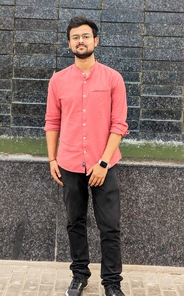Pranav Anand

About
Greetings! 👋 I am an aspiring AI researcher with a solid foundation in software development, poised to contribute my expertise to drive groundbreaking advancements in artificial intelligence. My background as a software developer provides me with a unique perspective on technology, and my passion for delving into the nuances of AI positions me as a valuable asset for pushing the boundaries of research in innovative directions. Eager to stay abreast of the ever-evolving tech landscape, I actively pursue opportunities to integrate cutting-edge technologies into research projects and navigate their seamless application across various domains.
🚀 As an aspiring AI researcher, I bring a wealth of expertise in leveraging Python and C# and their associated libraries and frameworks. My strengths lie in navigating the complex domains of machine learning, deep learning, computer vision, reinforcement learning, and natural language processing. I excel at applying these technical skills to drive research innovation, enhance algorithmic performance, and align research endeavors with strategic goals.
📚 Currently, my intellectual pursuits involve actively engaging in research papers and dissecting case studies relevant to the dynamic landscape of AI development. My commitment lies in unraveling the intricacies that shape successful research strategies, fostering a profound understanding of the factors driving innovation within the industry. This approach not only enhances my knowledge base but also equips me with valuable insights to make informed decisions and drive impactful outcomes in the realm of AI research.
🤝 I am proactively seeking opportunities to engage in collaborative ventures where I can leverage my skills and knowledge to drive impactful projects in AI research. I am enthusiastic about leading teams toward groundbreaking discoveries and am eager to join forces in the pursuit of pioneering advancements in the field of artificial intelligence. Let’s chart a course for success together!
Education
🏫 Bachelors in Computer Science and Engineering ‘22 - Thapar Institute of Engineering and Technology, Patiala, India.
Experience
🏭 Software Development Engineer at Landis Gyr [Aug 2022 - Present]
• Spearheaded the development of an automated system featuring advanced computer vision for smart devices. Orchestrated the end-to-end process, from conceptualization to implementation, by creating a seamless pipeline. Integrated data collection, precision labeling with Roboflow, Python-based preprocessing, and employed various YOLO frameworks in PyTorch. The streamlined testing processes resulted in a remarkable 30% boost in operational efficiency.
• Pioneered designing and implementing a sophisticated failure-resolution detection system, leveraging deep learning sequence models such as LSTM and RNN. Utilized extensive testing scenarios and diverse test cases to fortify system robustness and performance, leading to an 11% increase in overall accuracy. Focused on enhancing the product’s functionality and reliability.
• Actively contributed to diverse feature development in C# and .NET, proactively addressing and resolving bugs. Demonstrated a keen understanding of the Agile Software Development Life Cycle (SDLC) while overseeing the comprehensive development process.
🏭 Machine Learning Engineer Intern at WiJungle [Jan 2022 - Jun 2022]
• Spearheaded the design, development, and research initiatives for cutting-edge machine learning (ML) systems, meticulously crafting models and schemes that push the boundaries of innovation.
• Applied a discerning eye to the data journey, from strategically searching and selecting relevant datasets to the meticulous processes of data collection, web scraping, and data modeling, ensuring a robust foundation for subsequent analysis.
• Transformed raw data into meaningful insights through adept data visualization techniques, fostering a comprehensive understanding for system refinement. Demonstrated agility by actively engaging in continuous training and retraining of ML systems and models as needed.
• Delved into the intricacies of algorithmic use cases, evaluating and ranking them based on accuracy and success probability, thereby contributing to informed decision-making and optimization of ML solutions.
• Engaged in a perpetual learning cycle, immersing oneself in diverse existing frameworks, libraries, and the latest research papers, staying at the forefront of technological advancements and industry trends.
• Conducted rigorous testing, employing statistical analyses to interpret test results, ensuring the reliability and effectiveness of ML-based systems. This commitment to empirical validation underpinned the continuous enhancement of models and systems.
🏭 Research Intern at Tel Aviv University [Nov 2020 - Feb 2021]
• Worked under Dr. Parteek Bhatia in LAMBDA Labs on a computer vision, i.e. Worked on Developing a robust model for the identification of plant infestations involving leveraging the distinctive features presented by the holes on leaves as Region of Interest (ROI). This endeavor entails a comprehensive exploration of cutting-edge computer vision techniques, including but not limited to Semantic Segmentation and Edge Detection. By strategically employing deep learning architectures, the objective is to not only detect the presence of infestations but also to classify them based on severity, categorizing the affected areas into intervals such as 0%, 0-25%, 25-50%, 50-75%, and 75-100%. The real-world application of this model involves the analysis of crop images captured in field conditions, presenting a dynamic and challenging environment for accurate detection and classification. Through the integration of diverse computational methodologies, the aim is to enhance the precision and reliability of plant infestation detection, thereby contributing to more effective crop management strategies in agriculture.
• Final Result - Encountering challenges characterized by limited usable data, pronounced bias in labeling, and inadequate preprocessing of images—largely attributed to the compression of predominantly single-colored “green” images—our efforts were impeded by the absence of clear separation boundaries, compounded by the abundance of leaves in a single image. While groundbreaking results remained elusive, our endeavors yielded valuable insights. We have synthesized comprehensive guidelines for the subsequent data and image collection phase, aiming to rectify these limitations and pave the way for optimal outcomes in future analyses.